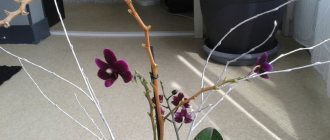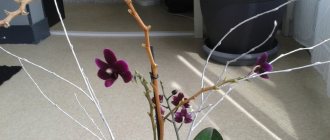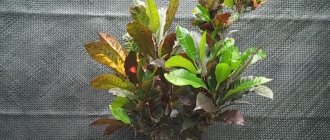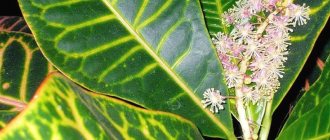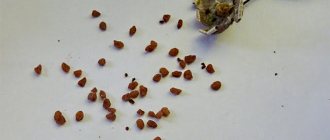There is real confusion in the minds of amateur flower growers with croton. They stubbornly call this a spectacular house plant, although in fact Croton grows in the wild or on tropical farms, where it is grown for medicinal purposes or to obtain seeds. And these are large trees or shrubs. In our houses it is not Croton that lives, but Codium. Moreover, only one species is the variegated codiaeum (Codiaeum variegatum) from the Euphorbiaceae family. In Europe it is often called "Joseph's cloak". There it became popular in the first half of the 19th century.
Codium variegated is an evergreen shrub that grows at home no more than 70 cm. Large (up to 30 cm) leathery leaves are arranged alternately on a straight branching trunk. The flowering is inconspicuous, the flowers are small, pale, the seeds are large. But the value of the plant is not in the flowers, but in the leaves - they have different shapes and incredibly beautiful colors: all shades of green, yellow, orange, red and even black! The decorative effect is enhanced by bright colored veins and spots (1).
There are at least 7 varieties of variegated codiaum, which differ in the shape of the leaf blade. For example, in the tortile form the leaf is heart-shaped with an elongated pointed tip, in trilobium the base of the leaf is deltoid, and the plate itself is divided into 3 parts.
Croton varieties
The popularity of this plant led to a lot of work by breeders who created original varieties and hybrids.
Excellent - its leaves are similar in appearance to oak leaves, the top is green with yellow veins, and the lower part of the leaf is red-burgundy.
Gold Star - graceful green leaves covered with numerous golden spots.
Missis Ayston is an elegant tree on which you can see leaves of cream, yellow and green at the same time.
Mummy - This variety has narrow, spiraling leaves that are orange-red in color with dark green stripes.
Petra is a compact bush up to 50 cm high with large green leaves with yellow veins.
Spirale is a very original variety with narrow bright leaves twisted around its axis.
Sunny star is a tree up to 80 cm high with thin yellow-green leaves.
Tamara is an elegant shrub up to 1 m high with white-cream-green leaves in the form of an elongated oval with a sharp tip and a wavy edge.
Zanziebare - distinguished by narrow long leaves of dark green color with yellow specks.
Zulu - with oddly shaped lance-shaped green leaves with yellow spots.
Botanical description of the plant
Croton is a bush covered with leathery leaves. Their shape can be different - asymmetrical, elongated-lanceolate, notched. Pointed and blunt-pointed leaf blades are also found.
Young leaves are usually a pale green-yellow color. After some time they acquire a brighter shade. It can be green or burgundy. Because of this foliage color, the bush resembles an autumn tree. There are a number of species and varieties of croton. At the same time, all are characterized by a common feature - pronounced venation.
Croton cannot boast of spectacular flowering. During this period, axillary drooping racemes appear on the bush, which include inconspicuous cream flowers.
Croton care at home
The homeland of croton (codiaum) is the tropical corners of India and Malaysia. And this determines its requirements for growing conditions.
“Many problems in growing codiaum can be avoided if you strictly observe the temperature regime,” says houseplant collector Elizaveta Starostina. – In summer, the plant is comfortable at a temperature of 20 - 25 ° C, in winter - not lower than 18 ° C. No temperature changes, cold window sills or drafts!
Photo: globallookpress.com
Priming
Of the ready-made mixtures, rose soil is most suitable for codiaum. However, experienced gardeners prefer to prepare the soil themselves. To do this, take leaf and garden humus, peat and coarse river sand in equal proportions. Add a glass of crushed wood soil and a handful of zeolite to 3 liters of the mixture. The reaction of the soil solution should be alkaline - 6 - 7.4 pH.
Lighting
This plant loves bright light, but does not tolerate direct sunlight - they “erase” the beautiful design and can even cause burns. The best place from spring to autumn is a window sill facing the east, west or southeast direction.
But in winter, the codiaum can be moved to a south-facing window sill. If the color of the leaves begins to fade, turn on the phytolamps!
Humidity
Codiaum loves moist soil and air. From April to October, watering is frequent and abundant up to 3 times a week. Make sure that the soil does not dry out more than 3 cm from the surface of the pot. In winter, one watering per week is enough. 30 minutes after watering, the water from the pan must be drained.
The plant responds very well to daily spraying and a humidifier. But this is not enough. Wipe the leaves on both sides daily with a soft, damp sponge - this increases humidity and removes dust and pests. Give your pet a warm shower once a month (2).
Water for irrigation and spraying should be settled, soft and warm - 2 - 4 °C above room temperature. Ideally use rain or filtered water.
Fertilizers
For codiaum, use complex mineral fertilizer for succulents and cacti. It is also recommended to use deciduous wood ash as fertilizer.
Feeding
Fertilizing is carried out only on moist soil, with solutions of complex mineral fertilizer. In spring and summer, take a full dose once every 3 weeks. In autumn and winter - 1/2 dose of fertilizer once every 1.5 months. Once every 2 months, add a teaspoon of wood ash to the pot and lightly loosen the top layer of soil.
Trimming
A beautiful crown and optimal size are formed by regular pruning. In young plants, shoots are pinched, in adults - pruning. The first pinching is done when the young plant reaches a height of 15 - 20 cm, then each shoot is cut to the outer bud as soon as it reaches 20 cm in length.
Photo: globallookpress.com
It is recommended to trim flower shoots and side shoots that protrude too much beyond the crown being formed.
When pinching the apical buds, the wounds become covered with milky sap; when cutting stems, it is recommended to powder the sections with crushed coal.
Pruning is carried out in the spring and, if necessary, in the summer. 2 - 3 days after pruning, the plants are watered and the crowns are sprayed with growth stimulants.
Important! The milky sap of the plant is poisonous, so carry out work only with gloves.
Pruning and crown formation
Croton side shoots grow more slowly than the central stem
Therefore, it is important to shape the crown of the flower so that the bush grows lush. Perform the first pinching of the plant when the codiaum reaches a height of 15 cm
This will provoke increased growth of side shoots. Repeat pinching when the branches grow 20 cm in length.
In the future, regularly shorten shoots that are too elongated and remove dried leaves, damaged and weak branches. And also cut out flower buds, because they drain the plant’s strength. After the procedure, be sure to sprinkle the cut areas with crushed charcoal.
Croton propagation at home
Croton (codium) can be propagated by seeds, cuttings and layering.
Seeds. During seed propagation, parental characteristics may not be preserved.
The seeds must be fresh; they are poured with hot water (60 °C) for 30 minutes, then allowed to swell in the same water for 24 hours. Sow in bowls with a mixture of peat and sand to a depth of 1 cm. Cover with film and place in a warm place. Water the tray regularly.
When two true leaves appear, the seedlings are planted in pots.
By cuttings. There are two possible rooting options: in soil and water. The optimal time for cuttings is February-April. The cuttings are cut 10-15 cm long, the lower leaves are removed. The milky sap is washed off with warm water and the sections are allowed to dry for 3 hours. Then the lower cut is dusted with Kornevin. The cuttings are planted in a pot with loose soil (perlite and peat) and covered with a jar. Place in a warm place (24 °C). Spray every day and pour water into the tray as needed. The rooting process lasts approximately 1 month. Then the plants are planted in pots with codiaum soil.
Cuttings can also be rooted in a glass of water. However, it will be necessary to maintain an optimal water temperature of 22 - 24 °C. When roots grow 1.5 - 2 cm long, the cuttings are planted in the ground, placed under film for 2 - 3 days and then the soil moisture is carefully monitored (2).
– They often write about the method of rooting codiaum with leaves. And indeed, the leaf develops roots quite quickly. However, then the process stops, because a growth bud is necessary for the appearance of a new plant. Therefore, you need just a cutting, at least a small piece of a stem with a leaf,” explains houseplant collector Elizaveta Starostina.
By layering. For varieties with long shoots, you can use the method of propagation by layering. To do this, remove the bark from the bare part of the branch - in a ring 1 cm wide, apply moistened sphagnum moss to the wound, wrap it with stretch film, securing it at the top and bottom. In a month you will see how the roots have sprouted through the moss. The branch under them is cut off and planted in the ground.
Possible problems during cultivation
Most often, codiaum is affected by spider mites, which appear if the leaves on the bush are not sprayed enough and washed poorly. The flower may also be attacked by scale insects and scale insects. Pests should be controlled using special insecticidal agents.
If the infestation with scale insects, scale insects and spider mites is still small, you can try wiping the stems and leaves with a tobacco-soap solution. After an hour and a half, it will need to be washed off so that it does not get into the ground.
Why does codiaum shed its leaves?
There may be three reasons why croton leaves fall in a pot:
- Drafts and low air temperature.
- Constantly insufficient watering. That is, drying out the roots.
- Very frequent watering, which is why the roots began to rot.
In the first case, the flower needs to find another place to grow. And in the second and third, it is necessary to change the watering regime.
What to do if croton leaves dry out
With age, the croton trunk gradually becomes bare . Its lower leaves dry out and fall off. This is a natural process and you should not be afraid. However, if a large number of leaves dry out and fall off, then most likely the plant does not have enough moisture.
Brown spots and dry edges of the leaves indicate that the flower is freezing and needs to be placed in more comfortable growing conditions.
If the leaves have dry tips , then the air in the room is dry. The plant needs to be sprayed more. You can place a flower pot on a tray with wet expanded clay.
Why did the croton drop its leaves?
The codiaum plant may lose its leaves because the roots are cold. Under such conditions, they simply stop absorbing moisture. The bush should be placed in a warm place with diffused good lighting, its leaves should be sprayed and a kind of greenhouse should be made by putting a transparent bag on the plant.
As you can see, careless attitude and improper care of croton at home can lead to diseases and pests on the plant. In order for it to delight you with its bright, magnificent leaves throughout the year, it must be surrounded with care and attention. For an apartment or office, this beautiful codiaum will be a real decoration.
Croton transplant at home
It is advisable to replant young plants 2 times a year, plants older than 2 years - once every 2 years, large adults are not replanted, but only replace the top layer of soil annually.
Photo: globallookpress.com
The first transplant is 2 weeks after purchase. The pot should be 3 - 5 cm in diameter wider than the old one. 3 cm of drainage must be placed at the bottom. Starting from the second transplant, the plants are turned over, trying not to destroy the earthen coma, but only slightly shaking off the old soil. Damaged and diseased roots are cut off and powdered with crushed coal.
The best time to transplant is spring. Please note that you cannot replant a flowering plant and a diseased one (except for root rot disease).
Croton diseases
Anthracnose. It appears as gray or brown spots on the leaves. The cause is often excessive watering and stagnation of water in the root zone.
For protection, spray the plant three times and water the soil with any fungicide, for example Fitosporin or Alirin (3).
Root rot. The first signs of the disease are the leaves turning pale. And then they dry out and fall off.
The plant must be urgently replanted by removing soft and damaged roots and sprinkling the sections with crushed coal. Add two Glyocladin tablets to the top layer of soil. Spray the plant and water it with Alirin solution (3).
Answers to readers' questions
What is the lifespan of a plant?
Codiaum is a long-lived plant, capable of actively developing and delighting with its appearance for more than 10 years.
Is this flower poisonous?
Like all Euphorbiaceae, croton contains toxic milky sap. It can cause skin ulcers, vomiting, and stomach upset.
Why do the leaves turn yellow (dry)?
There may be several reasons for this: too much soil moisture, root rot, or simply a deficiency of beneficial microelements.
Why does croton shed its leaves?
This is how it reacts to temperature fluctuations and drafts.
Croton pests
Spider mite. These pests leave small punctures and whitish spots on the leaves.
As a preventive measure, regular spraying and wiping the leaves with a damp sponge has worked well. It is recommended to thoroughly wash the affected plant with a sponge and soapy water, then spray it three times with an interval of 7 days with Actellik or Fitoverm (3).
Shield. Insects are noticeable on leaves and stems - they look like brown dry plaques.
The plant should be wiped with a cotton pad soaked in vodka, then washed with a soap solution, adding an infusion of tobacco dust (1 tablespoon per 1 liter of boiling water, boil for 30 minutes, leave for 24 hours, then strain and add 1 tablespoon of liquid laundry soap) . It is also recommended to spray with Actellik (3).

